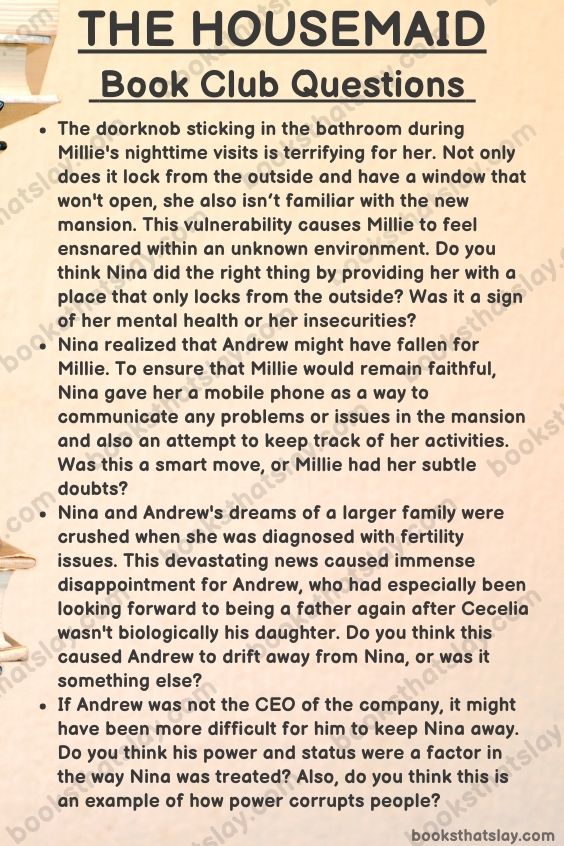15 The Housemaid Book Club Questions For Discussion
In “The Housemaid,” trusting any character is a dangerous game.
Freida McFadden masterfully uses unreliable narrators and shifting perspectives to keep you constantly questioning who to believe, and whose version of the truth is actually closest to reality.
If you and your book club are fascinated by stories that make you question everything, prepare to be enthralled.
These discussion questions will guide you as you pick apart the motivations, the lies, and the chilling secrets that drive the plot of this unforgettable novel.

The Housemaid Book Club Questions
- Millie and Nina exist on a spectrum of victimhood and culpability. Millie has a history of violence stemming from self-defense, while Nina’s violence is manipulative and stems from a desire for control. How does the novel make us question the lines between justifiable and unjustifiable violence, and how does this complicate the portrayal of these two women?
- The attic room becomes a symbolic prison for both Millie and Nina. It represents the hidden abuse within the Winchester marriage and ultimately becomes a space of both punishment and liberation. How does this confined space illuminate a larger discussion of hidden abuses within seemingly ‘perfect’ environments?
- Motherhood becomes a central and warped theme throughout the story. We see Nina’s desire for a child, Millie’s complicated feelings towards Cecelia, and Evelyn Winchester’s twisted methods of disciplining Andrew. How does *The Housemaid * use warped versions of motherhood to expose the darker, more controlling sides of traditional family structures?
- Nina meticulously orchestrates Andrew’s downfall. She deliberately paints herself as the unstable victim and positions Millie as a temptress with a violent past to manipulate Andrew. Given her own history of victimization, could we consider Nina’s manipulations to be a twisted form of self-preservation, even as they harm others?
- The ending of the novel feels intentionally open, with Nina helping Millie start a new life while hinting at repeating a similar cycle with her next employer. Does this suggest an inherent darkness in Nina that cannot be overcome, or could her actions be interpreted as a grim necessity within the corrupt systems of power she has survived within?
- The Winchester mansion serves as both a luxurious setting and a prison for the characters. The descriptions of the opulent rooms, the hidden attic room, and the surrounding landscape create a sense of claustrophobia. How does the physical setting of the novel mirror the psychological states of the characters, particularly Millie and Nina?
- McFadden uses the unreliable narrator technique throughout The Housemaid. Each woman reveals pieces of the story from her own perspective, leaving the reader to question motivations and decipher the truth. Where do the breaks and shifts in perspective occur, and how do they force the reader to re-evaluate their understanding of the events within the novel?
- Nina and Andrew represent a stark contrast between a desire for outward-facing normalcy versus a hidden darkness. The public views the Winchesters as a perfect family, yet their home is a war zone. How does the novel comment on the dangers of upholding social appearances at the cost of internal well-being?
- Mental illness is used both as a weapon and as a scapegoat. Nina is labeled with various diagnoses, which Andrew weaponizes against her to isolate and control her. How does the novel challenge the perception of mental health, especially how it can be used to manipulate and undermine women’s voices within abusive power structures?
- The theme of retribution courses throughout the novel. Both Millie and Nina enact their forms of revenge for what they’ve endured. Does the novel offer a clear moral stance on revenge, or does it leave the reader grappling with the complexities of seeking justice outside of conventional systems?
- Nina and Andrew put great effort into projecting the image of a perfect family to the outside world, yet the reality behind closed doors is horrific. How does the contrast between the seen and the unseen shape the plot’s suspense, the characters’ behaviors, and ultimately, the messages of the novel?
- Andrew’s childhood under Evelyn’s control reveals how a warped sense of ‘discipline’ and ‘perfection’ can be passed down, creating a cycle of abuse. How does the novel make us question the lines between appropriate discipline and destructive control, and how those in power define these terms?
- Both Nina and Millie have experienced forms of victimization and trauma. Yet, their responses are vastly different, with Nina becoming manipulative and Millie enacting physical violence. Does the novel excuse either form of response, or does it present them as complex products of their circumstances?
- How does Andrew’s portrayal as a ‘hidden monster’ and his ability to manipulate others challenge common tropes about abusers and victims? Does this complicate our sympathies for Millie’s actions, or does it reinforce the dangers of appearances?
- There is a clear overlap between “The Seen and The Unseen” and “The Interrelationships Among Discipline, Power, and Perfection”. Could the novel be making a statement about how the desire to uphold the image of perfection often perpetuates systems of abuse hidden in plain sight?
Check out our discussion questions for other books